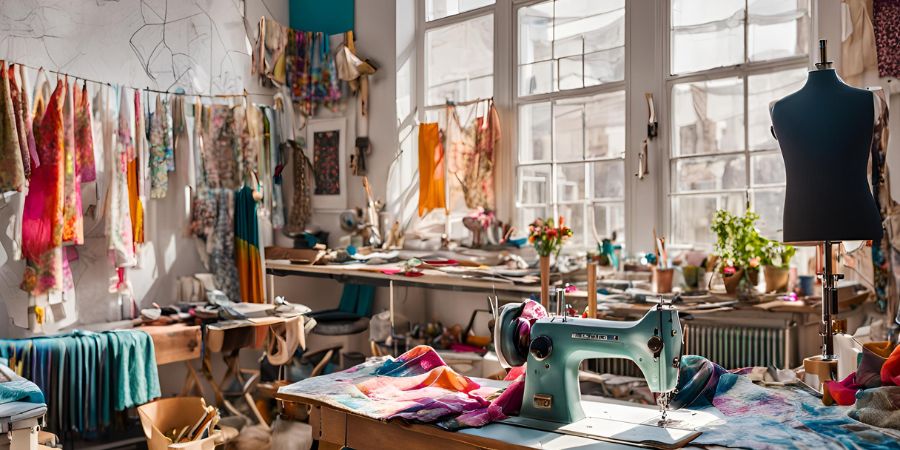Fashion design is a dynamic and creative field that requires a blend of artistic vision, technical skills, and business acumen. The work environment for a fashion designer can vary significantly based on their role, employer, and career stage. Whether designing haute couture gowns or mass-market clothing, the fashion design work environment is as diverse as the industry itself.
In this article, we’ll explore the various facets of a fashion designer’s work environment, touching on physical settings, collaborative teams, tools, challenges, and perks of the job.
Physical Work Environment of Fashion Designers
The physical environment in which fashion designers operate plays a vital role in their productivity and creativity. Here’s a closer look at some common settings:
1. Design Studios
Most fashion designers spend a significant amount of time in design studios. These studios are often equipped with drafting tables, sewing machines, fabric swatches, and mood boards. The atmosphere in a studio can range from serene and contemplative to bustling with activity during the lead-up to a major deadline.
Key Characteristics of Design Studios:
- Spacious layouts to accommodate materials and tools.
- Bright lighting for precision in sketching and stitching.
- Inspirational décor to foster creativity, such as art pieces or mood boards.
2. Corporate Offices
Fashion designers working for large brands or retail companies often work in corporate office settings. These environments typically include cubicles, meeting rooms, and computer workstations where designers can create digital patterns and collaborate with merchandising teams.
Benefits of Corporate Offices:
- Access to state-of-the-art design software.
- Team-oriented environment for brainstorming and ideation.
- Opportunities to interact with cross-functional departments.
3. Manufacturing Units and Factories
For designers involved in production, visiting manufacturing units and factories is a regular part of the job. These trips ensure that the designs are executed accurately and meet quality standards.
Key Aspects of Factory Visits:
- Monitoring sample production.
- Collaborating with pattern makers and seamstresses.
- Addressing any issues in material quality or garment construction.
Collaborative Work Environment in Fashion Design
Fashion design is rarely a solo endeavor. Designers interact with various professionals throughout the creative and production processes.
1. Working with Design Teams
In larger organizations, designers are part of a team that may include junior designers, textile experts, and graphic designers. Teamwork is essential for brainstorming ideas, refining designs, and ensuring cohesive collections.
How Teams Function:
- Brainstorming sessions to generate fresh ideas.
- Assigning roles based on expertise, such as fabric selection or technical sketching.
- Collaborative reviews to ensure the collection aligns with brand identity.
2. Interaction with Clients
Freelance designers or those in bespoke fashion interact directly with clients. Understanding client preferences, discussing budget constraints, and presenting design concepts are critical aspects of client collaboration.
Client Interaction Dynamics:
- Regular meetings to discuss progress and feedback.
- Presenting fabric samples, sketches, and prototypes.
- Adjusting designs based on client input.
3. Liaising with Suppliers and Vendors
Fashion designers also work closely with suppliers to source materials like fabrics, trims, and accessories. Strong vendor relationships can ensure timely delivery and quality consistency.
Importance of Vendor Collaboration:
- Negotiating prices for bulk materials.
- Staying updated on the latest textile trends.
- Ensuring sustainable and ethical sourcing practices.
Tools and Technologies in Fashion Design Work Environment
Technology plays a significant role in modern fashion design, streamlining processes and enhancing creativity.
1. Design Software
Programs like Adobe Illustrator, CorelDRAW, and CLO 3D are essential tools for creating digital patterns, visualizing designs, and producing technical specifications.
Advantages of Design Software:
- Time-saving compared to traditional sketching.
- Precise measurements for pattern making.
- Realistic 3D simulations of garments.
2. Sewing and Cutting Tools
Traditional tools like scissors, sewing machines, and dress forms remain indispensable in the fashion designer’s toolkit.
Why Traditional Tools Matter:
- They allow designers to test ideas quickly.
- Hands-on prototyping aids in understanding fabric behavior.
- Customization is easier with manual techniques.
3. Mood Boards and Trend Forecasting Tools
Fashion designers rely on mood boards to visualize themes and concepts. Trend forecasting tools and reports provide insights into upcoming styles and consumer preferences.
Role of Trend Forecasting:
- Staying ahead in a competitive industry.
- Identifying emerging color palettes, patterns, and silhouettes.
- Aligning designs with market demands.
Challenges in the Fashion Design Work Environment
Despite its glamorous reputation, fashion design is not without challenges. Designers face numerous hurdles that test their creativity, resilience, and adaptability.
1. Tight Deadlines: Fashion designers often work under pressure, especially during fashion weeks or seasonal launches. Deadlines can be intense, requiring long hours and meticulous attention to detail.
2. Competitive Industry: The fashion industry is fiercely competitive, with constant pressure to innovate. Designers must stay informed about trends and consumer behavior to remain relevant.
3. Ethical and Environmental Concerns: As sustainability becomes a priority, designers are expected to adopt eco-friendly practices. Balancing creativity with ethical considerations can be challenging but is increasingly important.
Perks and Rewards of a Fashion Design Career
While the work environment can be demanding, it also offers unique rewards that make the challenges worthwhile.
1. Creative Freedom: Fashion design allows individuals to express themselves artistically. Designers have the opportunity to bring their vision to life and set trends that influence global fashion.
2. Opportunities for Travel: Many designers travel for fabric sourcing, fashion shows, and client meetings. These trips can be inspiring and offer exposure to diverse cultures and styles.
3. Networking and Recognition: The fashion industry provides ample opportunities to network with celebrities, influencers, and other creative professionals. A successful collection can bring widespread recognition and career growth.
FAQs
Conclusion
The work environment for a fashion designer is as vibrant and varied as the industry itself. From creative studios filled with fabric and sketches to bustling offices where teams collaborate on the latest trends, each setting offers unique opportunities and challenges. Despite the pressure of tight deadlines and the need to constantly innovate, the rewards of a fashion design career — creative fulfillment, global recognition, and a chance to influence culture — make it a dream profession for many.
Understanding the nuances of this work environment is crucial for aspiring designers, as it prepares them to navigate the demands and seize the opportunities that come their way. Whether you’re working for a prestigious fashion house or launching your own brand, the journey promises to be as exciting as it is rewarding.


